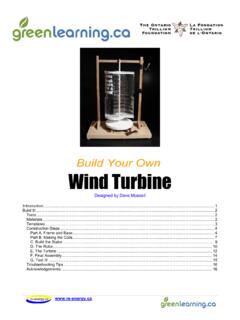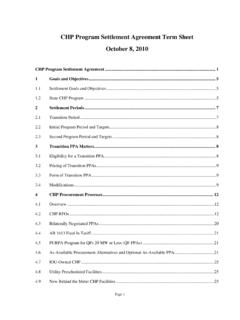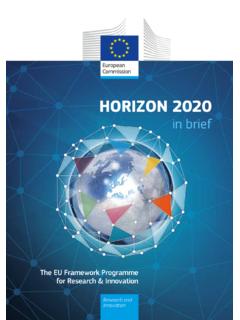Transcription of TOWARDS A WATER AND FOOD SECURE FUTURE
1 TOWARDS A WATERAND food SECURE FUTUREC ritical Perspectives for Policy-makersWHITE PAPERTOWARDS A WATERAND food SECURE FUTUREC ritical Perspectives for Policy-makers The outlook for 2050 is encouraging, globally, but much work is needed to achieve sustainable WATER use and ensure food security for AND AGRICULTURE ORGANIZATION OF THE UNITED NATIONSRome, 2015 Revised reprintWORLD WATER COUNCILM arseille, 2015 The designations employed and the presentation of material in this information product do not imply the expression of any opinion whatsoever on the part of the food and Agriculture Organization of the United Nations (FAO) concerning the legal or development status of any country, territory, city or area or of its authorities, or concerning the delimitation of its frontiers or boundaries.
2 The mention of specific companies or products of manufacturers, whether or not these have been patented, does not imply that these have been endorsed or recommended by FAO in preference to others of a similar nature that are not views expressed in this information product are those of the author(s) and do not necessarily reflect the views or policies of FAO. FAO & WWC 2015 FAO encourages the use, reproduction and dissemination of material in this information product. Except where otherwise indicated, material may be copied, downloaded and printed for private study, research and teaching purposes, or for use in non-commercial products or services, provided that appropriate acknowledgement of FAO as the source and copyright holder is given and that FAO s endorsement of users views, products or services is not implied in any requests for translation and adaptation rights, and for resale and other commercial use rights should be made via or addressed to information products are available on the FAO website ( )
3 And can be purchased through ivLIST OF TOPICAL BOXES vKEY MESSAGES: EXECUTIVE SUMMARY vii1. INTRODUCTION 12. food SECURITY: AVAILABILITY, ACCESS, UTILIZATION, AND STABILITY 3 Availability 3 Access 3 Utilization 4 Stability 53.
4 KEY MESSAGES: DISCUSSION 7 The Outlook for WATER and food in 2050 7 Critical Issues Determining the Outlook for 2050 9 Essential Policies and Investments 20 WATER Governance, Institutions, and Incentives 344. REFERENCES 41ivFOREWORDThe present White Paper has been prepared by the food and Agriculture Organization of the United Nations (FAO) and the World WATER Council (WWC), in support to the High Level Panel on WATER for food Security held at the Seventh World WATER Forum in Daegu, South Korea, April 2015. FAO and WWC wish to acknowledge the financial support of Deere & Company as contributing partner to the preparation and the conduct of the High Level Panel under which this publication has been OF TOPICAL BOXESBox 1.
5 WATER , food , and Agriculture in the Sustainable Development Goals 2 Box 2. Seeking Sustainable food and Agriculture: FAO s SFA Approach 6 Box 3. The Changing Role and Status of Smallholders 11 Box 4. Investments in Irrigation Technology Do Not Always Save WATER 12 Box 5. WATER Accounting and WATER Balance Analysis are Essential 14 Box 6. The WATER , Energy, and food Nexus 18 Box 7. Degrading Land and WATER Quality Increases Pressure on Limited WATER Resources 21 Box 8. Reducing food Losses and Waste Could Reduce Pressure on Land and WATER Resources 25 Box 9. Dryland Areas and Marginal Production Environments Are Already Severely WATER Stressed 29viiKEY MESSAGES: EXECUTIVE SUMMARYThe Outlook for WATER and food Security in 20501.
6 The prospect for global food supply between now and 2050 is encou-raging, although many of the poor will remain food insecure. food production will be sufficient to support a global population of 9 to 10 billion in 2050, although food and nutritional insecurity will persist in many regions. Substantial public and private-sector investments and policy interven-tions are needed between now and 2050, particularly in agriculture, to reduce poverty, increase incomes, and ensure food security for many of the world s rural and urban residents. 2. While there will be sufficient WATER to satisfy the demand for food at the global level, an increasing number of regions will face growing WATER scarcity, which will impact rural and urban livelihoods, food security and economic , WATER resources will be sufficient to produce the food required in 2050, but many regions will face substantial WATER scarcity.
7 WATER shortages will result in increasing competition, which will constrain agricultural produc-tion and affect the incomes and livelihood opportunities of many residents in rural and urban areas. Innovative and more effective governance mechani-sms, together with investments in WATER technologies and infrastructure will be needed to mitigate the impacts of growing WATER shortages to ensure WATER is allocated in such a way as to SECURE its efficient use, protection of the natural resource base, and to ensure access to WATER for household use and agricultural production. Countries in WATER -scarce regions will increasingly need to devise food security strategies that explicitly consider structural food supply deficit and trade arrangements that will provide protection from food price Issues Determining the Outlook for 20503.
8 Much of the net growth in the global population up to 2050 will occur in the cities of developing countries, thus increasing urban demands for WATER and net growth in the global population between now and 2050 will occur in the cities of lower income countries. Increasing urbanization will impact the volume and quality of WATER available for agriculture, particularly in peri-urban areas. Agriculture can support larger numbers of urban residents, but farmers must be able to retain access to sufficient WATER to support crop and livestock production. The interaction between cities and the countryside will become viiiTowards a WATER and food SECURE FUTURE : Critical Perspectives for Policy-makersincreasingly intertwined and, if well managed, will offer new opportunities for mutual benefit, including recycling and reuse of WATER and nutrients held in municipal waste At the same time, in 2050 a substantial share of the global population, and many of the poor, will continue to earn their living from with increasing urbanization, in 2050 much of the global population, and most of the poor, will continue to earn their living in agriculture.
9 Thus, investments in agriculture in lower income countries will be critical in raising incomes of the poor and enabling them to achieve household food and nu-tritional In 2050, agriculture will continue to be the largest user of WATER globally, accounting for more than half of withdrawals from rivers, lakes and aquifers, and will need to become increasingly will continue to be the largest user of developed WATER resources in most countries, often accounting for 70 percent or more of WATER withdrawals from rivers, lakes and aquifers. Increasing demand for WATER in cities and from industries, and for environmental flows, will reduce the volume of WATER avai-lable for agriculture in many areas.
10 Yet, globally, the volume of WATER transpi-red in crop and livestock production must increase between now and 2050 to keep up with increasing demand. In many regions, farmers will need to adapt to less WATER being available for irrigation, while facing increasing demands for their products. Innovative technologies and investments are required for edu-cation and training in the management of WATER for both irrigated and rainfed settings so as to achieve more productive use of WATER in agriculture. 6. Climate change will increasingly necessitate investment in measures to enhance adaptation in agriculture that are mostly related to WATER change will bring greater variation in weather events, more frequent weather extremes, and new challenges requiring adaptation, particularly with regard to WATER and agriculture.
















